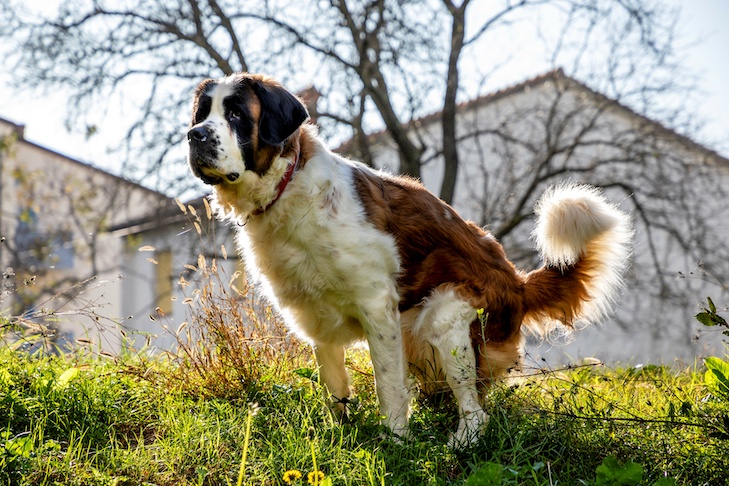Dogs can have problems with their anus and rectum just like people can. You might see your dog scooting (dragging their bottom) across the carpet or straining when they squat to defecate. Your first thought might be hemorrhoids, a common ailment in people.
But can dogs get hemorrhoids? Or is something else going on under your dog’s tail? Here’s what to look for and what to do if your dog is having rear-end issues.
Can Dogs Get Hemorrhoids?
In humans, hemorrhoids are swollen and irritated veins in the lower rectum and anus. Like varicose veins, they can develop under the skin around the anus or inside the rectum. They are caused by extra pressure on the veins in that area, a result of conditions like chronic constipation. Hemorrhoids in people can be itchy, painful, or to lead to bloody stool.
However, Dr. Jerry Klein, Chief Veterinary Officer for the American Kennel Club, explains dogs don’t get hemorrhoids. This is because dogs don’t suffer extra pressure on the relevant veins. “Technically, dogs do not get hemorrhoids,” he says, “because a dog’s body and gastrointestinal system is horizontal rather than vertical, causing less pressure on the blood vessels in the rectum and anus.”
Rear End Problems Dogs May Have
If dog hemorrhoids aren’t the problem, what might be wrong with your pet’s butt? There are several possible issues:
- Rectal or anal polyps. These small growths of extra tissue are uncommon and are usually benign (non-cancerous), but the larger the polyp, the higher the chance of it being cancerous.
- Rectal or anal masses. These tumors can be either benign or malignant (cancerous). Treatment involves surgery to remove the mass, which will be most effective if the tumor has yet to spread to other parts of the dog’s body.
- Perianal fistulas. These are chronic, bad-smelling wounds caused by a tunnel-like formation in the skin between the inside of the anus and the skin around the outside of the anus. Dogs over the age of seven are at higher risk. This condition is seen most often in German Shepherd Dogs.
- Perianal hernia. This is a hernia (an internal organ that has pushed through a weak area in the tissue or muscle) near the anus, and it might be detectable as a swelling below and to the side. Some breeds, including Boston Terriers, Boxers, Dachshunds, and Pekingese, are more susceptible than others.
- Prolapsed rectum. This is a rare condition where part of the rectum protrudes from the anus. It usually occurs in young dogs that regularly must strain to poop or have serious diarrhea.
Anal Gland Problems
The most common rear-end issue in dogs involve their anal glands. These are two oval-shaped sacs, one on either side of a dog’s anus, which are a bit like the scent glands in skunks. The glands produce a liquid with a strong, fishy stink. Dogs can’t spray their anal gland fluid; instead, it’s normally squeezed out when they poop, leaving a unique scent signature on their stool. Dogs can also involuntarily release their anal glands when they are anxious or scared.
Many dogs, especially large and giant breeds, never have problems with their anal glands. But other dogs, particularly small breeds, can suffer from clogged anal glands (also known as impacted anal glands), where the gland or duct from the gland to the anus becomes plugged. The glands can also become infected or abscessed, and cancer can develop in them.
Anal gland issues are often caused by the dog’s inability to squeeze out the sacs while defecating. This can be from chronic soft stool or poor muscle tone in overweight dogs. Allergies, lack of dietary fiber, or dermatitis can also contribute to anal sac problems.
To relieve the buildup of fluid, some dogs need their anal glands manually emptied. However, owners shouldn’t attempt this on their own without previous instruction from their vet. Dr. Klein explains, “A veterinarian can show an owner the proper way to express them. But if it’s not done properly, or if the gland is obstructed, more harm than good can occur.”

Signs Your Dog Has Rear End Issues
With so many potential behind problems, it’s important to know what to watch for. Be on the lookout for the following:
- Excessive scratching or licking of the anus. All dogs clean themselves, but any attention beyond the usual could indicate a problem.
- Scooting or dragging their behind along the ground. Dogs do this to relieve itching or pain in the anal area.
- Swelling, inflammation, or redness around the anus
- Pain when pooping or pus or blood in the stool
- Straining to poop
- Bleeding or pus near the anus or rectum
- Holding the tail in an unusual position
If you see any of the above, Dr. Klein advises, “An owner should carefully look to see if there are any soiled remnants that can easily be wiped or washed off. After that, a warm compress may be applied while contacting a veterinarian to evaluate the problem. No manipulation or remedies should be applied without the advice of a veterinarian.”
This article is intended solely as general guidance, and does not constitute health or other professional advice. Individual situations and applicable laws vary by jurisdiction, and you are encouraged to obtain appropriate advice from qualified professionals in the applicable jurisdictions. We make no representations or warranties concerning any course of action taken by any person following or otherwise using the information offered or provided in this article, including any such information associated with and provided in connection with third-party products, and we will not be liable for any direct, indirect, consequential, special, exemplary or other damages that may result, including but not limited to economic loss, injury, illness or death.

